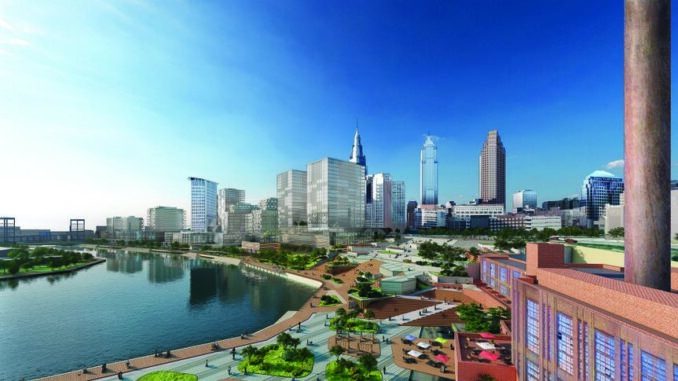
Separate development proposals could drive the city’s waterfront renovation
By Terry Troy
In his first “State of Downtown” address to the Cleveland City Club, Michael Deemer, new president and CEO of the Downtown Cleveland Alliance (DCA), summed up Cleveland’s downtown as “resilient in the face of adversity.”
Deemer, who took over the reins of DCA after its former CEO and founder Joe Marinucci stepped down last summer, also recognized the significant generational change that is taking place within the city, particularly with November’s mayoral election on the horizon.
While the change of leadership is certainly important, Cleveland may soon realize significant renovation projects that will change both the lakefront and riverfront of its downtown area.
Last month, Bedrock, a full-service real estate firm specializing in innovative city building strategies, teamed up with the city of Cleveland on a comprehensive proposal that will transform the Cuyahoga River in downtown. Earlier this year, city officials unveiled a similar proposal for Cleveland’s lakefront, this one driven by the Cleveland Browns.
Bedrock’s long-term vision for the riverfront hinges on the partnership between the company and the city rebuilding the urban infrastructure with a focus on sustainability and resiliency, including new public open spaces, enhanced pathways to the riverfront and transit-oriented development conforming to the recently adopted guidelines of the city’s Vision of the Valley.
The public investments will enable additional private investments and create opportunities for downtown property owners and developers at large to develop commercial, residential, retail, entertainment and adaptive reuse projects. In turn these developments will spur job growth and provide opportunities for new affordable homes for renters and owners in a diverse and inclusive riverfront setting. The 20- to 30-year plan will create a 15-minute neighborhood and 18-hour city for residents, investors, professionals and visitors in Cleveland’s growing city center.
Strategically aligned with the Vision for the Valley, the new public/private partnership seeks to optimize and reengage approximately 130 acres of nascent (with potential) riverfront land linking downtown Cleveland in an unprecedented and meaningful way. The plan seeks to take full advantage of the various public funding opportunities and is designed to position the city to compete favorably for federal funding opportunities.
“The city, with community partners, has created a compelling vision for the future of the downtown. As one of the largest property owners in downtown Cleveland we believe that a strategic partnership with the city at this time will inject the needed public and private funds to implement the first phase of the Vision for the Valley and unlock the tremendous potential of the riverfront,” said Kofi Bonner, CEO of Bedrock when revealing the proposal.
“The initial efforts will focus on replacing aging infrastructure with sustainable and resilient systems, providing for a more walkable, bikeable and transit friendly downtown. These public improvements will set the stage for a dramatic new riverfront community with thousands of homes, businesses, entertainment and community facilities and services.”
For its part, the Lake Erie shoreline proposal being driven by the Cleveland Browns is equally exciting and includes a retooling of the Shoreway near the First Energy Stadium, where eastbound traffic would exit at West Sixth Street turning onto a new Shoreway Boulevard at West Third. The proposal also calls for a hotel, a pedestrian promenade and other buildings that would surround the stadium.
Both proposals come at a time when downtown Cleveland is poised for unprecedented growth. More than 9,400 jobs have been added to downtown Cleveland, the largest jobs hub in the state, in the last decade. Home to more than 20,000 residents, downtown Cleveland’s population has more than doubled since 2000, outpacing its peer cities. The vision for the lakefront and riverfront should help downtown to meet the DCA’s projected population growth of 30,000 residents by 2030.
